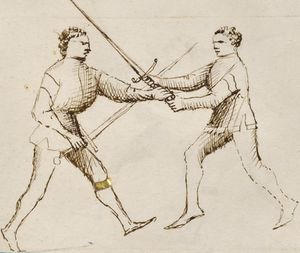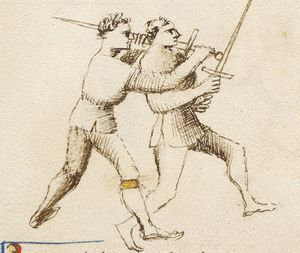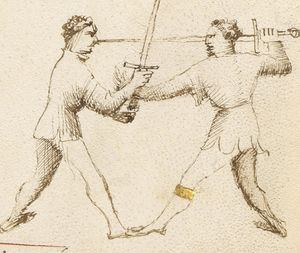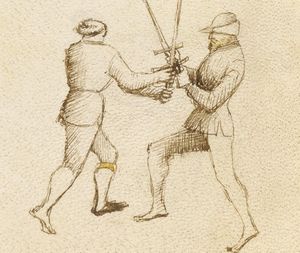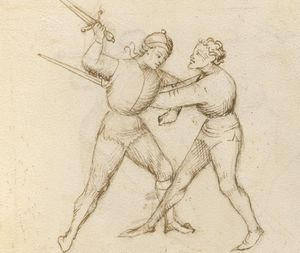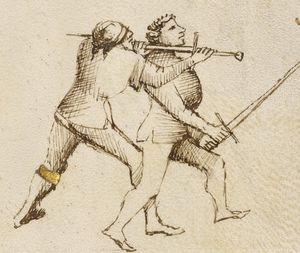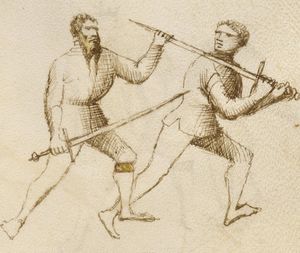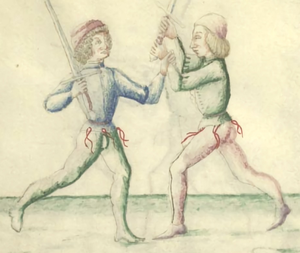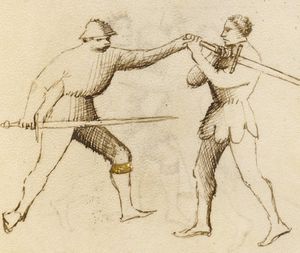|
|
You are not currently logged in. Are you accessing the unsecure (http) portal? Click here to switch to the secure portal. |
Fiore de'i Liberi/Sword in Two Hands/Narrow Play
Images |
Images |
PD |
Morgan Transcription [edit] |
Getty Transcription [edit] |
|||
|---|---|---|---|---|---|---|---|
| [No Image] |
[48] Here commences play of gioco stretto (narrow play) with a sword two-handed, in which it will be of every reason covers and injuries and binds and dislocations and grips and disarms of swords and beats (sbatter) to the ground in diverse ways. And there will be remedies and their counters of every reason, which you need to offend or defend. |
Here begins the play of the sword in two hands, the narrow play, the method of breaking all thrusts and cuts, in the which will be every method of covering, striking, and binding, and dislocations, and grapples, and takings of the sword, and beating to the ground in diverse ways. And there will be remedies and counters of every category that should offend or defend. |
[16r-t] E qui comenza zogo de spada a doi mane, zogo stretto. E'l modo de rompe tute punte e tagli. In lo quale serano d'ogni rasone, coverte, feride, e ligadure, e dislogadure, e prese, e tore de spada, e sbatere in terra, per diversi modi. E serano gli remedii, e gli contrarii de zaschuna rasone che bisogna a offendere e difendere. |
[27v-d] ¶ Qui cominza zogho de spada a doii man zogo stretto, in lo quale sara d'ogni rasone coverte, e feride e'ligadure. e dislogadure e prese, e tore de spade, e sbatter in terra per diversi modi. E sarano gli rimedii e gli contrarii de zaschuna rasone che bisogna a offender e a defender. |
|||
[49] Because of the way that we stand here crossed, We stay here crossed, and from this crossing which we do, we can do all the following plays, one of us as the other one. And all these plays will follow one another, as I said before. |
We stand here crossed and from this crossing that we make, all the plays that follow us can be made, and by one of us as easily as the other. And all of these plays will follow, one after the other, as was previously said. |
[16r-a] Nui stasemo qui incrosadi e di questo incrosare che noii fazemo. Tuti gli zoghi che noii segueno fargle possemo. Acosi uno de noii, quale l'altro. E tuti gli zoghi seguirano uno l'altro como denanci e dito. |
[28r-a] ¶ Noi stasemo qui incrosadi, e di questo incrosar che noii fazemo, tutti gli zoghi che noii segueno far gli possemo, chosi uno di noii quale l'altro. E tutti gli zoghi seguirano l'uno l'altro come denançi e ditto. |
[22a-a] Per modo che noii stasemo aqui incrosadi |
|||
[50] Because of your hilt which I hold in my hand, Because of the crossing that the Master did, with the right foot forward, I complete the first play, that is: I pass [forward] with the left foot, and with my left hand I pass over my right arm and grab the handle of his sword in the middle of his hands, in the middle of his handle. And with cuts (taglio) and thrusts I can injure him. And this grip can be done with one-handed sword or two-handed sword. The crossing can be done either from above or under-hand if making this grip. |
From the crossing that the Master has made with his right foot forward, I complete the first play—that is, I step with my left foot and I pass my left hand over my [right] arm and grasp the hilt of his sword in between his hands (in the middle of the hilt), and then I could strike with edge and point. And this catch can be made as easily with the sword in one hand as with the sword in two hands, and this catch can be made as easily crossing under the hands as over. [In the Paris, the Scholar's sword is in front of his arm.] |
[16r-b] Per lo incrosar che a fatto lo magistro cum lo pe dritto denanci io comprischo lo primo zogo, zoe che io passo cum lo pe stancho, e cum la mia mane stancha passo di sopra lo mio dritto brazo, e piglo lo suo mantenir dela spada sua, in mezo le soe[!] mane zoe in mezo delo mantenir. E cum taio e punta, Io lo posso ferir, e questa presa se po fare cosi a spada de una mane, come a doe mane, e cosi a incrosar de sotto mane come di sopra se po far tal presa. |
[28r-b] ¶ Per lo incrosare ch'a fatto lo magistro, cum lo pe dritto denanci io complisco lo primo zogho, zoe Che io passo cum lo pe stancho e cum la mia mane stancha passo di sopra lo mio dritto brazzo, e piglo el suo mantenir di'sua spada in mezo le soe[!] mane zoe in mezo delo mantenir. E cum taglo e punta io lo posso ferir. E questa presa si po fare a spada d'una e de doii mane. & a incrosare tanto di sopra quanto di sotta mane si po far tal presa. |
[22a-b] Per lo mantiger[!] tuo che in man io tegno |
[26r-c] ¶ Percutiam nulloque tuum prohibente tenebo | ||
[51] Because my sword has received a blow This is another play which comes from the crossing of my Master. And like that one is crossed that can do this play and these others which follow: That the player can grab the player in this way and injure him in the face with the pommel of his sword. Also he can injure him with a fendente in the head, before he could do a cover quickly. |
This is another play that comes from the crossing of my Master, and as he is crossed, he can make this play and the others that follow after—that is, he can make or grasp the player in this way to strike him in the face with the pommel of his sword. Also, he can strike him in the head with a downward blow before [the player] could make a cover ready |
[16r-c] Questo e uno altro zogo che vene delo incrosar dello mio magistro. E como ello e incrosado ello po fare questo zogo e lli altri po che segueno de dredo, zoe ch'ello po fare overo piglare lo çugadore a questo modo, e ferirlo in lo volto cum lo pomo de sua spada. Anchora po ferirlo de fendente in la testa. Innanci ch'ello fare coverta presta. |
[28r-c] ¶ Questo e un altro zogho che vene del incrosar del mio magistro. E commo ello e incrosado ello po fare questo zogo e'gl'altri che qui dredo siegueno. zoe, Che'lo zugadore po pigliare a questo modo lo zugadore, e ferirlo in lo volto cum lo pomo dela spada sua. Anchora po ferirlo de fendente in la testa, inançi ch'ello possa fare coverta presta. |
[22a-c] Per la mia spada che a'recevudo colpo |
[26v-a] ¶ Hoc capulo vultum ferio tibi nempe feroci. | ||
[52] This is another strike with my pommel, This is another injuring with the pommel. And if you can do it immediately, if he has his face uncovered, then do it without doubt, because you can do it armoured or unarmoured. With this play you can take four teeth out of one's mouth, as he has experienced. And if you wanted, you could shove the sword at his neck, as the student does after me. |
This is another strike of the pommel and it can be done quickly; if his face is uncovered then do it without fear, because it may be done armored or unarmored. You will bore four teeth from his mouth with this play (as has been proven), and if you wanted, you could throw the sword to his neck as does the Scholar that is after me. |
[16r-d] Questo e uno altro ferir de pomo e se po far subito, se lo volto e discoverto fallo senza dubito, Che lo se po fare armado e disarmado. Quatro denti fora butta de boccha a uno cum tale zogo, che l'a provado. E lla spada se volesse al collo te poria butar come fa dredo da mi quello scolaro. |
[28r-d] ¶ Questo e un'altro ferir de pomo. E se po far subito Si lo volto a discoverto, fa lo senza dubito. Che ello si po fare armado e disarmado. Quatro denti butta Fior[!] di bocha a uno cum tal zogo, si ch'el l'a provado. E la spada al collo se volesse te poria butare, como fa dredo a'mi quello scolare. |
[22a-d] Aquesto e un altro ferir de mio pomo |
[26v-c] ¶ Ictus hic est alter capulo referire sodalem / | ||
|
[53] For the play which is before me, and as the student said, I have positioned my sword at your neck, and I can cut/slice (tagliare) your throat well, because I feel that you don't have a punto de colare (point of resistance?). [In the Morgan, the Scholar's right foot is inside of (behind) his opponent's right foot.] |
From the play that came before me and as the Scholar has said, I have placed my sword at your neck and I could cut your throat well because I feel that you do not have an armored collar. |
[16v-a] Per lo zogo che m'e denanci, e como lo scolar ha ditto io t'o posta la spada al collo. E lla gola te posso ben taglar. Per o ch'io sento che tu non ai punto di colaro. |
[28v-a] ¶ Per lo zogho che m'e denanzi e como lo scolar a ditto io t'o posta la spada al collo, e la gola te posso ben taglare, per che i sento che tu non hai punto de colare. |
[27r-c] ¶ Te iacio in terram magno/ quem precipis / actu | |||
[54] I have hindered your sword with my arm, When I am crossed, I pass with a cover, and I injure you in your arms in this part. And this thrust you get in the face. And if I advance the left foot, both your arms will be bound. Or, that in the other play after me of grabbing you, you are bound at the sword by the hilt's retention. |
When I am crossed, I step with a cover and I strike to your arm in this match and then I put this point in your face. And if I advance my left foot, I will bind up both your arms. Or I will grasp you in this play that comes after, that is, I will bind your sword and hold it by the hilt. [In the Paris, the Master is missing his crown. In the Morgan and Paris, the Master has his hand in position but hasn't grabbed his opponent's arm.] |
[16v-b] Quando io sono incrosado io passo cum coverta E fiero in gli toii brazi a questo partito. E questa punta pogno in lo to[!] volto. E si lo pe stancho io acresco trambe le brazi ti ligaro. Overo che in questo zogo che m'e dredo te pigliro zoe che te ligaro la spada, e per l'elzo la tegnero. |
[28v-b] ¶ Quando io son incrosado io passo cum coverta, e fiero in gli toii brazzi in questo partito. E questa punta ti metto in lo volto. E si lo pe stancho io acresco trambe le brazze te ligaro. Overo che in questo zogho che m'e dredo ti pigliro, zoe che ti ligaro la spada e per l'elço la tigniro. |
[22b-d] La tua spada cum lo mio braco o intardada |
|||
[55] I have trapped your sword by the hilt, This is the grip that the student before me said to do to you. I can injure you without danger. I retain your sword's hilt, I will give you cuts and thrusts cheaply (with no risk?). And this play breaks all sword-disarms, and doing it immediately spoils gioco stretto. [In the Getty, the Master is missing his crown.] |
The catch that the Scholar who came before me mentioned, that is what will I do; I hold the hilt of your sword and I could strike you without trouble: with my point and my edge I'll make you a deal. And this play breaks every taking of the sword, and making it quickly ruins the narrow play. [In the Paris, the Master is missing his crown.] |
[16v-c] La presa che dise lo scolar che m'e denanci quella ti fazo, ferir te posso senza impazo e tegno l'elzo de tua spada, de punte e tagli ti faro derada. E questo zogo rompe ogni tore de spada e llo zogo stretto subito farlo quello guasta. |
|
[23a-b] La tua spada per l'elço si o inpresonada |
|||
|
[56] When I am crossed, I come to gioco stretto. The hilt of my sword enters between your hands, and lifting your arms with your sword high. I put my left arm over yours [arms], with reversed hand, and I will injure your arms with your sword under my left arm. And I will not finish injuring you until I am tired. The play which is after me, done by the student, is my play, and my play that one wants to do. |
[28v-d] ¶ Quando io son incrosado io vegno al zogho stretto. Ello elzo dela mia spada enfra le toii mane metto. E levo le toii brazze cum la tua spada in erto. E'llo mio brazo stancho butero per sopra li toii a man riversa, e serero li toii brazi cum la tua spada sotto lo mio brazzo mancho. E de ferir non ti lassaro in fin che saro stancho. Lo zogo che m'e dredo che fa lo scolaro. Ello e mio zogo, e quello te voglio fare. |
||||||
[57] I locked your arms with my left arm, The student who is before me has completed the play which I said to do. Your arms have been bound in ligadura mezana (middle bind). Your sword is prisoner, and it can not help you. And with mine I can cause you a lot of injuries. Without doubt I can put my sword to your neck. I can immediately do the play which is after me. |
[29r-a] ¶ Del scolaro che m'e denançi io complisco'l zogho. e quello che luii di far a ditto io l'o fatto. Le braze t'o ligade in ligadura mezana. La tua spada e in prisone e non ti po iutare. E cum la mia feride asaii te posso fare. La mia spada ti posso metter al collo senza dubito. E'l zogo che m'e dredo te posso far subito. |
[23a-a] Toii braçi cum lo mio stancho sono seradi |
|||||
|
[58] From the play before, you can do this play, which is: When the student has injured the player well, retaining these arms with the sword bound well with his left arm, you shoved your sword to his neck, and put him in this part. And if I shove him to the ground I have completed the play. |
[29r-b] ¶ Del zogho che denançi si fa questo zogho, che quando lo scolaro a ben ferido lo zugadore tegnando gli brazzi cum la spada ben ligadi cum lo suo brazzo mancho la sua spada gli buta al collo e metilo in questo partito. Se io lo butto in terra lo zogho o complito. |
||||||
|
[59] If someone covers himself on the right hand side, grab his sword with your left hand, in this way, and injure him with a thrust or with a cut (taglio). And if you want, you can cut (tagli) him in his face or neck with his own sword, as is drawn. Also, when I have injured you well, I can abandon my sword and grab yours, in the way that the student after me does. |
This is another method of throwing someone to the ground, and it is done in this fashion: the Scholar crosses with the player on the right side and comes to the narrows. He grasps the sword of the player with his left hand (passing the middle of the sword), … [Text accompanies subsequent image.] |
[15v-a] Questo e uno altro modo de butar uno in terra. E si fa per tal modo lo scolar se incrosa cum lo zugadore dela parte dritta, e si vene ale strette. E cum la mane stancha pigla la spada delo zugadore passando la mezamento della spada, e subito butta la sua spada in terra, e quella del zugadore propia, gle mette al collo piglando lo mantenir al mezo zoe in mezo dela mane del zugadore. E cum lo suo pe dritto dredo lo suo dritto, e per tal modo lo butar in terra cum la sua spada propria. |
[29r-d] ¶ Se uno se covra dela parte dritta, piglia cum la tua mane stancha la sua spada per questo modo, e fierilo di punta voii cum lo taglio. E se tu voii tu gli tagli cum la sua spada lo volto o voii lo collo per lo modo ch'e depinto. Anchora quando io t'o ben ferido, io posso abandonar la mia spada e pigliar la tua per lo modo che fa lo scolaro che m'e di dredo. |
||||
[60] I have in hand the catch that I have sought with you From the play that the student before me does, I do this play: With his sword I cut (taglio) his face, sending him to the ground. I will show you well how true this art is. |
…and immediately he throws his sword to the ground and thrusts the player's own sword to his neck, grasping the hilt in the middle—that is, between the hands of the player—with his right foot behind [the player's] right. And in this fashion he throws him to the ground with his own sword. |
[29v-a] ¶ Del zogho del scolaro che m'e denanzi, si fazo questo zogho, cum la sua spada gli taglio Lo volto mandandolo in terra. Ben ti mostraro che tal arte sia vera. |
[22b-b] In mane ho la presa che tegho o'cerchada |
[30v-a] ¶ Accipio manibus capturam tempore longo | |||
[61] From the right cover I have caught you so well, |
This play is made in this fashion, that is, that one goes with a middle blow against a middle blow to his left side, and then quickly goes to the narrows with a cover. He throws his sword to the neck of his companion, at the same time grasping his right hand with his left (as you see depicted here). He can then throw him to the ground without fail, thrusting his right foot behind [the player's] right. |
[15r-c] Questo zogo se fa per tal modo zoe che uno vada cum lo colpo mezano contra lo mezano de parte riversa e subito vada cum coverta ale strette. E buta la sua spada alo collo dello compagno, piglando la sua mane dritta cum la sua stancha de si in stesso come aqui dipento. Butarlo po in terra senza falimento metendo lo suo pe dritto dredo lo suo dritto. |
[22b-c] Per drita coverta io t'o cussi ben preso |
[30r-a] ¶ Dexterior tectura monet / ut gutture prendam. | |||
[62] This is the cover of the backhand |
[23b-a] Questa e coverta dela riverssa mano |
||||||
[63] From the cover of the backhand have I enclosed you here: |
[23b-b] Per la coverta dela riverssa mano aqui t'o aserato |
||||||
[64] This is a strong catch that comes from the backhand: |
[23b-c] Questa e una forte presa che ven de man riverssa |
||||||
|
[65] If someone covers himself on the left side, grab his left hand with your left hand, with all the pommel of his sword, and push forwards, and with a thrust and cut (taglio) you can injure him well. |
[29r-c] ¶ Se uno se covra dela parte riversa, pigla cum la sua mane stancha cum la sua man stancha cum tutto lu pomo dela sua spada, e penzilo in dredo, e cum punta e taglio ben lo po ferire. |
||||||
[66] For that you could overthrow (batter) the swords you must come into the binding (Translation by Anonymous) [This Master appears to be missing his crown.] |
[28r-b] ¶ Ut mihi tu posses ensem convellere leva | ||||||
[67] From the cover on the right side, thus have I caught you: |
[24a-a] Per la coverta de man drita acossi io t'o preso |
[30v-c] ¶ In terram resupinus ibis. vultumque tenebit | |||||
| [[File:MS |
- ↑ Added later: "cum". Potentially could be read as "eum" but we believe "cum" is a useful clarification of this sentence.
- ↑ While lacertos and brachia refer specifically to the upper and lower arms respectively, this is probably an attempt by the translator to avoid repetition, rather than specific parts of the arm that are affected by the actions. We have retained the specificity for linguistic reasons. We used arm instead of shoulder in the following couplet because the technique does not work with the shoulder.
- ↑ "a farlo subito" appears twice, but neither is struck out.
- ↑ These umlaut-like dots appear on a few other pages, where they indicate words that should be read as a pair. Here the marked words are both part of a phrase naming a technique, similar to other times the dots appear. Interestingly, on this page it looks like the dots were written by the original scribe (for example, the dots over the a in spataeque have the same faded look as the a). However, appearing on so few pages, these dots don't seem to be part of the overall orthographic style of the manuscript.

